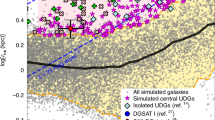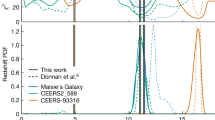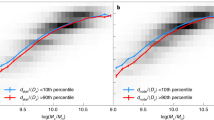Abstract
Filaments connecting haloes are a long-standing prediction of cold-dark-matter theories. Here we present a detection of the cosmic web emission connecting two quasar-host galaxies at redshift z ≈ 3.22 in the MUSE Ultra Deep Field (MUDF), observed with the Multi Unit Spectroscopic Explorer (MUSE) instrument. The very deep observations unlock a high-definition view of the filament morphology, a measure of the transition radius between the intergalactic and circumgalactic medium, and the characterization of the surface brightness profiles along the filament and in the transverse direction. Through systematic comparisons with simulations, we validate the filaments’ typical density predicted in the current cold-dark-matter model. Our analysis of the MUDF, an excellent laboratory for quantitatively studying filaments in emission, opens a new avenue to constrain the physical properties of the cosmic web and to trace the distribution of dark matter on large scales.
This is a preview of subscription content, access via your institution
Access options
Access Nature and 54 other Nature Portfolio journals
Get Nature+, our best-value online-access subscription
27,99 € / 30 days
cancel any time
Subscribe to this journal
Receive 12 digital issues and online access to articles
118,99 € per year
only 9,92 € per issue
Buy this article
- Purchase on SpringerLink
- Instant access to full article PDF
Prices may be subject to local taxes which are calculated during checkout




Similar content being viewed by others
Data availability
The Very Large Telescope data used in this work are available from the European Southern Observatory archive https://archive.eso.org/ either as raw data or phase 3 data products64.
References
Frenk, C. S., White, S. D. M., Davis, M. & Efstathiou, G. The formation of dark halos in a universe dominated by cold dark matter. Astrophys. J. 327, 507–525 (1988).
Cen, R., Miralda-Escudé, J., Ostriker, J. P. & Rauch, M. Gravitational collapse of small-scale structure as the origin of the Lyman-Alpha forest. Astrophys. J. Lett. 437, L9–L12 (1994).
Lukić, Z. et al. The Lyman α forest in optically thin hydrodynamical simulations. Mon. Not. R. Astron. Soc. 446, 3697–3724 (2015).
Peacock, J. A. et al. A measurement of the cosmological mass density from clustering in the 2dF Galaxy Redshift Survey. Nature 410, 169–173 (2001).
Tempel, E. et al. Detecting filamentary pattern in the cosmic web: a catalogue of filaments for the SDSS. Mon. Not. R. Astron. Soc. 438, 3465–3482 (2014).
Rauch, M. The Lyman alpha forest in the spectra of QSOs. Annu. Rev. Astron. Astrophys. 36, 267–316 (1998).
Haardt, F. & Madau, P. Radiative transfer in a clumpy universe. IV. New synthesis models of the cosmic UV/X-ray background. Astrophys. J. 746, 125 (2012).
Gould, A. & Weinberg, D. H. Imaging the forest of Lyman limit systems. Astrophys. J. 468, 462–468 (1996).
Bacon, R. et al. The MUSE second-generation VLT instrument. In Proc. Ground-based and Airborne Instrumentation for Astronomy III Vol. 7735 (eds McLean, I. S. et al.) 773508 (SPIE, 2010).
Morrissey, P. et al. The Keck Cosmic Web Imager integral field spectrograph. Astrophys. J. 864, 93 (2018).
Martin, D. C. et al. Intergalactic medium emission observations with the Cosmic Web Imager. I. The circum-QSO medium of QSO 1549+19, and evidence for a filamentary gas inflow. Astrophys. J. 786, 106 (2014).
Husband, K., Bremer, M. N., Stanway, E. R. & Lehnert, M. D. Dissecting the complex environment of a distant quasar with MUSE. Mon. Not. R. Astron. Soc. 452, 2388–2395 (2015).
Borisova, E. et al. Ubiquitous giant Lyα nebulae around the brightest quasars at z ~ 3.5 revealed with MUSE. Astrophys. J. 831, 39 (2016).
Arrigoni Battaia, F. et al. QSO MUSEUM I: a sample of 61 extended Ly α-emission nebulae surrounding z ~ 3 quasars. Mon. Not. R. Astron. Soc. 482, 3162–3205 (2019).
Fossati, M. et al. MUSE analysis of gas around galaxies (MAGG) – III. The gas and galaxy environment of z = 3–4.5 quasars. Mon. Not. R. Astron. Soc. 503, 3044–3064 (2021).
Cantalupo, S., Arrigoni-Battaia, F., Prochaska, J. X., Hennawi, J. F. & Madau, P. A cosmic web filament revealed in Lyman-α emission around a luminous high-redshift quasar. Nature 506, 63–66 (2014).
Umehata, H. et al. Gas filaments of the cosmic web located around active galaxies in a protocluster. Science 366, 97–100 (2019).
Bacon, R. et al. The MUSE Extremely Deep Field: the cosmic web in emission at high redshift. Astron. Astrophys. 647, A107 (2021).
Cai, Z. et al. Keck/Palomar Cosmic Web Imagers reveal an enormous Lyα nebula in an extremely overdense quasi-stellar object pair field at z = 2.45. Astrophys. J. Lett. 861, L3 (2018).
Arrigoni Battaia, F. et al. Discovery of intergalactic bridges connecting two faint z ~ 3 quasars. Astron. Astrophys. 631, A18 (2019).
Herenz, E. C., Hayes, M. & Scarlata, C. Deciphering the Lyman α blob 1 with deep MUSE observations. Astron. Astrophys. 642, A55 (2020).
Martin, D. C. et al. Extensive diffuse Lyman-α emission correlated with cosmic structure. Nat. Astron. 7, 1390–1401 (2023).
Revalski, M. et al. The MUSE Ultra Deep Field (MUDF). III. Hubble Space Telescope WFC3 grism spectroscopy and imaging. Astrophys. J. Suppl. Ser. 265, 40 (2023).
Fossati, M. et al. The MUSE Ultra Deep Field (MUDF). II. Survey design and the gaseous properties of galaxy groups at 0.5 < z < 1.5. Mon. Not. R. Astron. Soc. 490, 1451–1469 (2019).
Lusso, E. et al. The MUSE Ultra Deep Field (MUDF) - I. Discovery of a group of Lyα nebulae associated with a bright z ≈ 3.23 quasar pair. Mon. Not. R. Astron. Soc. 485, L62–L67 (2019).
Rosdahl, J. & Blaizot, J. Extended Lyα emission from cold accretion streams. Mon. Not. R. Astron. Soc. 423, 344–366 (2012).
Rahmati, A. et al. The distribution of neutral hydrogen around high-redshift galaxies and quasars in the EAGLE simulation. Mon. Not. R. Astron. Soc. 452, 2034–2056 (2015).
Kereš, D., Katz, N., Weinberg, D. H. & Davé, R. How do galaxies get their gas? Mon. Not. R. Astron. Soc. 363, 2–28 (2005).
Dekel, A. et al. Cold streams in early massive hot haloes as the main mode of galaxy formation. Nature 457, 451–454 (2009).
Rauch, M., Becker, G. D. & Haehnelt, M. G. Observational aspects of galactic accretion at redshift 3.3. Mon. Not. R. Astron. Soc. 455, 3991–3999 (2016).
Daddi, E. et al. Three Lyman-α-emitting filaments converging to a massive galaxy group at z = 2.91: discussing the case for cold gas infall. Astron. Astrophys. 649, A78 (2021).
Mackenzie, R. et al. Revealing the impact of quasar luminosity on giant Lyα nebulae. Mon. Not. R. Astron. Soc. 502, 494–509 (2021).
Nielsen, N. M. et al. An emission map of the disk–circumgalactic medium transition in starburst IRAS 08339+6517. Nat. Astron. 8, 1602–1609 (2024).
de Beer, S. et al. Resolving the physics of quasar Lyα nebulae (RePhyNe): I. Constraining quasar host halo masses through circumgalactic medium kinematics. Mon. Not. R. Astron. Soc. 526, 1850–1873 (2023).
Wilde, M. C. et al. CGM2 + CASBaH: the mass dependence of H i Lyα–galaxy clustering and the extent of the CGM. Astrophys. J. 948, 114 (2023).
Kikuchihara, S. et al. SILVERRUSH. XII. Intensity mapping for Lyα emission extending over 100–1000 comoving kpc around z ~ 2–7 LAEs with Subaru HSC-SSP and CHORUS data. Astrophys. J. 931, 97 (2022).
Lujan Niemeyer, M. et al. Surface brightness profile of Lyman-α halos out to 320 kpc in HETDEX. Astrophys. J. 929, 90 (2022).
Guo, Y. et al. Median surface-brightness profiles of Lyman-α haloes in the MUSE Extremely Deep Field. Astron. Astrophys. 688, A37 (2024).
Arrigoni Battaia, F., Hennawi, J. F., Cantalupo, S. & Prochaska, J. X. The stacked LYα emission profile from the circum-galactic medium of z ~ 2 quasars. Astrophys. J. 829, 3 (2016).
Izquierdo-Villalba, D. et al. The build-up of pseudo-bulges in a hierarchical universe. Mon. Not. R. Astron. Soc. 488, 609–632 (2019).
Izquierdo-Villalba, D. et al. From galactic nuclei to the halo outskirts: tracing supermassive black holes across cosmic history and environments. Mon. Not. R. Astron. Soc. 495, 4681–4706 (2020).
Lusso, E. et al. The MUSE Ultra Deep Field (MUDF). IV. A pair of X-ray weak quasars at the heart of two extended Lyα nebulae. Mon. Not. R. Astron. Soc. 525, 4388–4404 (2023).
Nelson, D. et al. The IllustrisTNG simulations: public data release. Comput. Astrophys. Cosmol. 6, 2 (2019).
Byrohl, C. & Nelson, D. The cosmic web in Lyman-alpha emission. Mon. Not. R. Astron. Soc. 523, 5248–5273 (2023).
Cantalupo, S. et al. The large- and small-scale properties of the intergalactic gas in the Slug Ly α nebula revealed by MUSE He ii emission observations. Mon. Not. R. Astron. Soc. 483, 5188–5204 (2019).
Lofthouse, E. K. et al. MUSE Analysis of Gas around Galaxies (MAGG) – I: survey design and the environment of a near pristine gas cloud at z ≈ 3.5. Mon. Not. R. Astron. Soc. 491, 2057–2074 (2019).
Weilbacher, P. M. et al. The MUSE Data Reduction Pipeline: Status after preliminary acceptance Europe. In Astronomical Data Analysis Software and Systems XXIII Vol. 485 (eds Manset, N. & Forshay, P.) 451–454 (Astronomical Society of the Pacific, 2014).
Foreman-Mackey, D., Hogg, D. W., Lang, D. & Goodman, J. emcee: the MCMC hammer. Publ. Astron. Soc. Pac. 125, 306–312 (2013).
Arrigoni Battaia, F., Obreja, A., Costa, T., Farina, E. P. & Cai, Z. The luminosity–area relation of z > 2 quasars’ Lyα Nebulae. Astrophys. J. Lett. 952, L24 (2023).
Hennawi, J. F. & Prochaska, J. X. Quasars probing quasars. IV. Joint constraints on the circumgalactic medium from absorption and emission. Astrophys. J. 766, 58 (2013).
Henriques, B. M. B. et al. Galaxy formation in the Planck cosmology – I. Matching the observed evolution of star formation rates, colours and stellar masses. Mon. Not. R. Astron. Soc. 451, 2663–2680 (2015).
Springel, V. et al. Simulations of the formation, evolution and clustering of galaxies and quasars. Nature 435, 629–636 (2005).
Hui, L. & Gnedin, N. Y. Equation of state of the photoionized intergalactic medium. Mon. Not. R. Astron. Soc. 292, 27–42 (1997).
Scholz, T. T. & Walters, H. R. J. Collisional rates and cooling within atomic hydrogen plasmas. Astrophys. J. 380, 302–306 (1991).
Rahmati, A., Pawlik, A. H., Raičević, M. & Schaye, J. On the evolution of the H i column density distribution in cosmological simulations. Mon. Not. R. Astron. Soc. 430, 2427–2445 (2013).
Benitez-Llambay, A. py-sphviewer: Py-sphviewer v.1.0.0. Zenodo https://doi.org/10.5281/zenodo.21703 (2015).
Kollmeier, J. A. et al. Lyα emission from cosmic structure. I. Fluorescence. Astrophys. J. 708, 1048–1075 (2010).
Astropy Collaboration et al. Astropy: a community Python package for astronomy. Astron. Astrophys. 558, A33 (2013).
Astropy Collaboration et al. The Astropy Project: building an open-science project and status of the v2.0 core package. Astron. J. 156, 123 (2018).
Astropy Collaboration et al. The Astropy Project: sustaining and growing a community-oriented open-source project and the latest major release (v5.0) of the core package. Astrophys. J. 935, 167 (2022).
Harris, C. R. et al. Array programming with NumPy. Nature 585, 357–362 (2020).
Virtanen, P. et al. SciPy 1.0: fundamental algorithms for scientific computing in Python. Nat. Methods 17, 261–272 (2020).
Hunter, J. D. Matplotlib: a 2D graphics environment. Comput. Sci. Eng. 9, 90–95 (2007).
Fumagalli, M. Exploring an uncharted portion of the universe with a MUSE ultra deep field. ESO Archive https://doi.org/10.18727/archive/84 (2023).
Acknowledgements
This project received funding from the European Research Council (ERC) under the European Union’s Horizon 2020 research and innovation programme (grant nos 757535 and 101026328) and from Fondazione Cariplo (grant no. 2018-2329). It was supported by the Italian Ministry for Universities and Research (MUR) programme ‘Dipartimenti di Eccellenza 2023–2027’, within the framework of the activities of the Centro Bicocca di Cosmologia Quantitativa (BiCoQ). D.I.-V. acknowledges financial support provided under the European Union’s H2020 ERC Consolidator Grant ‘Binary Massive Black Hole Astrophysics’ (B Massive, grant no. 818691). S.C. and A.T. gratefully acknowledge support from the ERC under the European Union’s Horizon 2020 Research and Innovation programme grant no. 864361. P.D. acknowledges support from the NWO grant no. 016.VIDI.189.162 (‘ODIN’) and warmly thanks the European Commission’s and University of Groningen’s CO-FUND Rosalind Franklin programme. S.B. acknowledges support from the Spanish Ministerio de Ciencia e Innovación through project no. PID2021-124243NB-C21.
Author information
Authors and Affiliations
Contributions
D.T. analysed the observations and was the main author of the manuscript. M. Fumagalli coordinated the MUDF programme, participated in the data analysis, and coauthored the manuscript. M. Fossati reduced and analysed the observations and participated in the analysis and manuscript writing. A.B.-L. contributed to the simulation analysis and D.I.-V. created and provided the SAM light cone and contributed to the analysis. All coauthors participated in preparing the manuscript.
Corresponding authors
Ethics declarations
Competing interests
The authors declare no competing interests.
Peer review
Peer review information
Nature Astronomy thanks Edmund Christian Herenz and the other, anonymous, reviewer(s) for their contribution to the peer review of this work.
Additional information
Publisher’s note Springer Nature remains neutral with regard to jurisdictional claims in published maps and institutional affiliations.
Extended data
Extended Data Fig. 1 Lyα emission image with noise and mean spectra.
Top, Optimally extracted Lyα image on top of three collapsed wavelength layers at the central wavelength of the quasar nebula emission. The contour levels are 0.02, 0.06, 0.3 and 2 × 10−18 erg cm−2 s−1 arcsec−2 (light-grey, black, light-orange, purple). The green crosses represent the position of the detected Lyα emitters within 1500 km s−1 from the average redshift of the two quasars. Bottom, Normalized mean spectra in velocity space extracted from the white boxes labeled from A to H in (a). The \({{\rm{F}}}_{\lambda }^{\max }\) are the maximum flux density values used to normalize the mean spectra in units of 10−21 erg s−1 cm−2 Å−1. The vertical dashed blue line represents the zero velocity reference calculated from the first moment of the line, and the horizontal dashed green line represents the 1σ noise level of the spectrum.
Extended Data Fig. 2 Extraction apertures for surface brightness profiles of nebulae and filament.
Left, Extraction apertures (black annuli for Nebula 1, blue annuli for Nebula 2, and green boxes for the filament) used to extract the surface brightness profiles, superimposed to the Lyα emission map, included solely for illustrative purposes. The two black dots mark a ≈ 15 pkpc radius where the quasar’s PSF residuals dominate the signal. QSO1 and QSO2 are indicated by the two black arrows, respectively. Right, Same as Left but for the transverse surface brightness profile. In the background of both images, shown in grey, is a white-light image of the region imaged by MUSE.
Extended Data Fig. 3 3D distance distribution of selected pairs.
The frequency distribution of the 3D physical distance between each selected pair (blue histogram) and the corresponding cumulative probability function (red line) are shown. The distribution is normalized to the number of selected pairs. A large fraction of MUDF pair twins are found to be sufficiently close to be interacting in some form.
Extended Data Fig. 4 Virial halo mass distributions for bright and faint quasars.
Left, The virial halo mass distribution in the SAM of the bright quasars \((\log ({{\rm{L}}}_{{\rm{bol}}}/{\rm{erg}}\,{{\rm{s}}}^{-1} )=47.3\pm 0.3)\) selected across the full-sky is shown in grey. The red curve represents the distribution of bright quasars among the selected pairs that mimic the MUDF system in the sky. (b) Right, Same as Left but for the faint quasars \((\log ({{\rm{L}}}_{{\rm{bol}}}/{\rm{erg}}\,{{\rm{s}}}^{-1} )=46.3\pm 0.3)\). In blue, the subsample resembling the MUDF system in the sky. All distributions are normalized to the bin width and the number of bright and faint sources obtained from their respective selections. Dashed lines indicate the mean values along with the 16th and 84th percentiles.
Extended Data Fig. 5 Median hydrogen density profiles for close and distant pairs.
The median hydrogen density profile along the filament of the selected close and distant pairs separated by a 3D distance of < 1 pMpc (blue line) and > 2 pMpc (orange line), are shown. Both profiles are plotted as a function of the normalized 3D physical distance between the two halos. The shaded regions represent the 16th and 84th percentiles of the profiles distribution. The black dashed lines represent ten times the hydrogen critical density of the Universe at this redshift, the threshold used to compare the properties of the two subsamples.
Extended Data Fig. 6 Transverse median hydrogen density profile for physically connected pairs.
The transverse median hydrogen density profile of the physically connected pairs separated by a 3D distance < 1 pMpc is shown. The sky-blue colored region represents the 16th and 84th percentiles of the profiles distribution.
Extended Data Fig. 7 Transverse median surface brightness profiles for physically connected pairs.
The median transverse surface brightness profiles of the selected pairs with a 3D distance below 1 pMpc in TNG300-1, TNG100-1 and TNG50-1 are shown, respectively. The blue line represents the emission contribution from recombinations only, while the orange line represents both recombinations and collisional excitations. The emission contribution from the maximal fluorescence model is also shown as a black line. The red points represent the measured data and their errors for the transverse surface brightness profile in MUDF. The shaded regions denote the 16th and 84th percentiles of the profile distributions.
Rights and permissions
Springer Nature or its licensor (e.g. a society or other partner) holds exclusive rights to this article under a publishing agreement with the author(s) or other rightsholder(s); author self-archiving of the accepted manuscript version of this article is solely governed by the terms of such publishing agreement and applicable law.
About this article
Cite this article
Tornotti, D., Fumagalli, M., Fossati, M. et al. High-definition imaging of a filamentary connection between a close quasar pair at z = 3. Nat Astron 9, 577–588 (2025). https://doi.org/10.1038/s41550-024-02463-w
Received:
Accepted:
Published:
Issue Date:
DOI: https://doi.org/10.1038/s41550-024-02463-w



